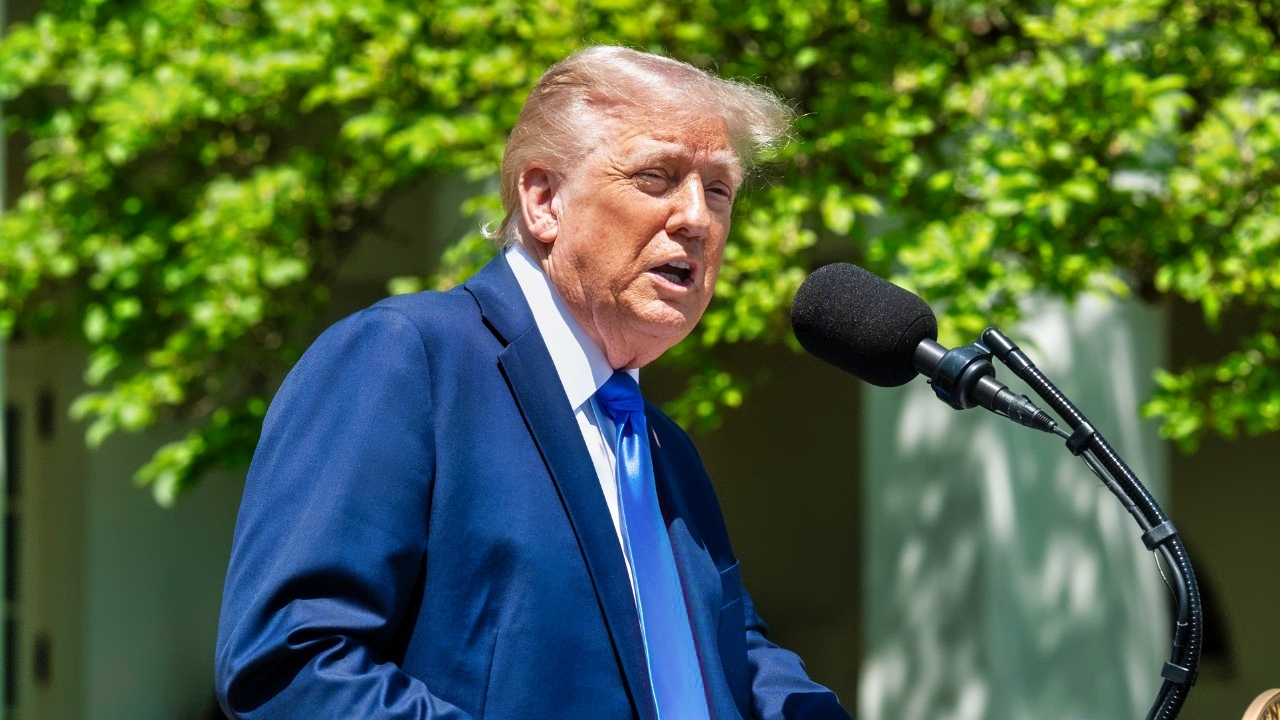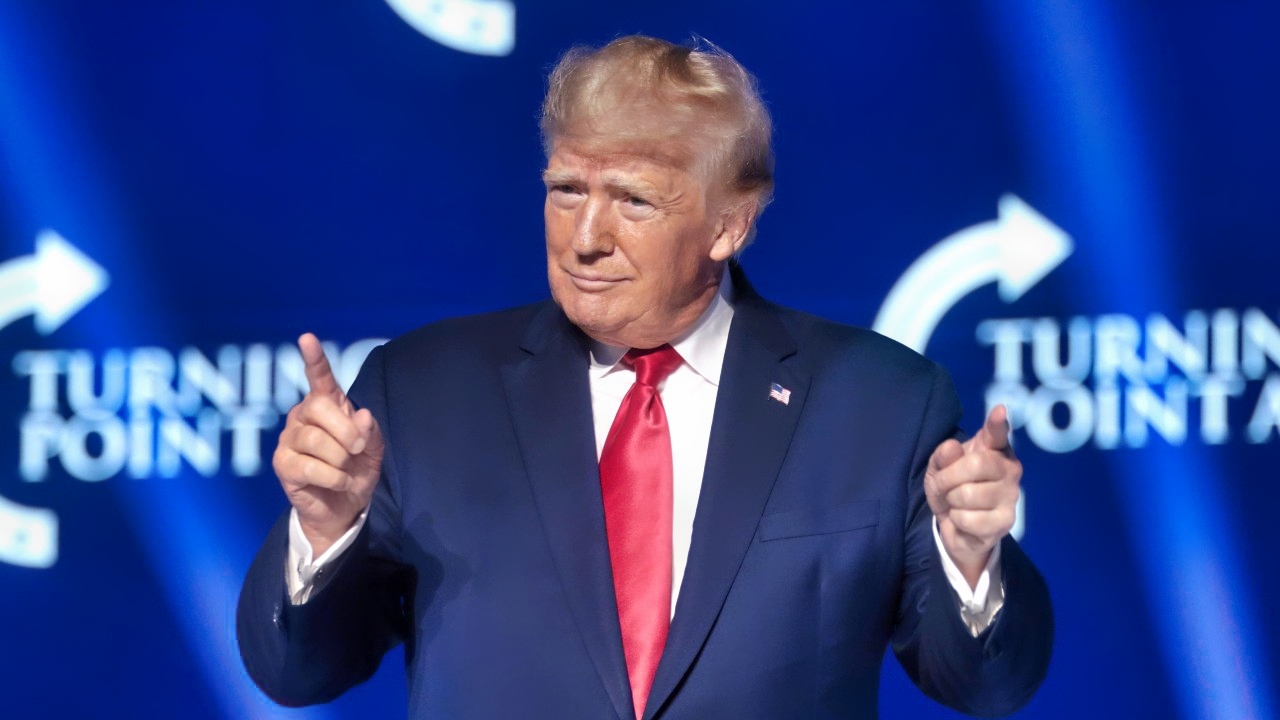Key Points and Summary – The Supreme Court heard Learning Resources, Inc. v. Trump, testing whether the president can use IEEPA to levy sweeping tariffs.
-Several conservative justices signaled skepticism of relying on “emergencies” for open-ended duties, though outcomes remain uncertain.

President Donald Trump delivers remarks at a National Day of Prayer event, Thursday, May 1, 2025, in the White House Rose Garden. (Official White House Photo by Joyce N. Boghosian)
-Even if the Court limits IEEPA, many tariffs could persist under other laws (e.g., Trade Act §122, Tariff Act §338).
-Business groups argue Americans, not foreign exporters, pay the cost via higher prices.
-The White House says it has a Plan B and frames tariffs as vital to security. Analysts call the ruling a coin flip—but expect most existing tariffs to stay, via new legal hooks.
What if the Supreme Court Rules Against Trump on Tariffs?
Throughout his first year in office, President Donald Trump has been imposing tariffs on countries all over the world, often pulling them and reimposing them. The result has often been chaos, which has affected everything from the economy to international relations. The tariffs have, in some cases, led to trade deals, but in other cases have caused uncertainty.
“Trump issued an executive order that initially imposed a tariff of at least 10% on goods from most countries doing business with the United States,” NPR said of the tariffs. “Goods from countries like China have been hit with much higher tariffs—up to 145%, though they have since come down. Imports from allies like Canada and Mexico have been taxed at 25%; Canada’s rate was later increased to 35%.”
Then there’s the separate question of whether the president has the unfettered power to impose tariffs.
On Wednesday, that question went before the United States Supreme Court in a case titled Learning Resources, Inc. v. Trump. And there are indications that the justices were skeptical of the Administration’s arguments.
Per CNN, even the conservative justices — including Chief Justice John Roberts and Justices Amy Coney Barrett, Neil Gorsuch, and Brett Kavanaugh — appeared to express “deep skepticism” of what the administration was putting forward.
“While justices had tough questions for both sides, a majority expressed reservations about the administration relying on declared emergencies to issue the unchecked tariffs,” CNN said.
Justices asking skeptical questions, however, do not always indicate how they are going to rule. This famously happened in the 2011 Supreme Court case involving the constitutionality of the Affordable Care Act, when the justices didn’t appear to buy into the Obama Administration’s arguments, although they later upheld the health care law.
Clarifying the Law
According to Reuters, the White House’s position on the President’s authority to impose tariffs is based on the International Emergency Economic Powers Act (IEEPA), a 1977 law from the Carter Administration. That law granted the president the authority to regulate imports and exports during times of national emergency.
Trump declared the $1.2 trillion US goods trade deficit, as of last year, a national emergency.
The power to impose tariffs is constitutionally assigned to Congress, although presidents in the past have often imposed tariffs unilaterally. However, per NBC News, no president has ever used IEEPA as a justification for imposing tariffs.
Earlier this year, however, a lower court found the Trump Administration exceeded its authority in using the stated pretext to impose tariffs. This judgment was a result of a lawsuit, in which the plaintiffs were affected businesses—including a New York-based wine and spirits importer named Victor Owen Schwartz—as well as the attorneys general of 12 mostly Democratic-led states.
“The thing is, there’s such a misconception out there that foreign entities are paying the tariffs,” Schwartz, the plaintiff, said, per NPR. “I can’t say this enough times: Americans are paying the taxes. American business is paying the taxes, and it will be passed on to consumers.”
NPR reported, before the arguments, that veteran Supreme Court litigator Neal Katyal, challenging the tariffs, would pursue the argument that the word “tariff” doesn’t even appear in the statute in question.
“The idea that every president had this power all along—Presidents Reagan to Obama—and none of them knew it and all of them have been spending all this time negotiating with Congress to try and get tariff authority when they had it from the start, is just too fanciful to believe,” the attorney says, per NPR.
The story also said that 38 briefs have been filed on behalf of the challengers, representing more than a thousand organizations and coming from across the political spectrum. On the other hand, only six briefs have been filed by those on the administration’s side of the case.
Trump Speaks
While the President did not attend the oral arguments in person, he has spoken up on Truth Social, calling the case “one of the most important in the History of the Country” in a social media post on Sunday.
“If a President was not able to quickly and nimbly use the power of Tariffs, we would be defenseless, leading perhaps even to the ruination of our Nation,” the president said in the post.
“It will be, in my opinion, one of the most important and consequential Decisions ever made by the United States Supreme Court. If we win, we will be the Richest, Most Secure Country anywhere in the World, BY FAR. If we lose, our Country could be reduced to almost Third World status.”
Trump further addressed the tariff issue with the press this week.
“If we don’t have tariffs, we don’t have national security, and the rest of the world would laugh at us because they’ve used tariffs against us for years and took advantage of us,” he said aboard Air Force One.
White House Press Secretary Karoline Leavitt, meanwhile, told the press this week that “the White House is always preparing for Plan B,” including in the case of tariffs.
How Will the Court Rule?
What is the Supreme Court likely to do in the case? Experts are unsure, according to Yahoo Finance.
Yahoo asked Raymond James managing director Ed Mills and Veda Partners managing partner Henrietta Treyz for their take on the case, and both described the odds as a “coin flip.”
Treyz called it a “base case” that “50% to 65% odds that the Supreme Court will side with two lower courts and say the president doesn’t have this authority.”
Terry Haines of Pangaea Policy, however, said he’s advising clients that a decision siding with Trump is slightly more likely, although “the case isn’t a slam dunk either way, and may well not yield a simple binary yes/no result on tariffs.”
What if They’re Struck Down?
There is currently a 6-3 conservative majority on the Supreme Court, including three appointees of Trump himself, and the Court has tended to side with the President on most major questions.
Even if the argument goes against the Trump Administration, according to a Reuters analysis published before the arguments, it appears likely that the tariffs will remain in place, but probably under a different pretext. Some of the tariffs already imposed, for instance, were not imposed under IEEPA, but rather by other authorities.
US Treasury Secretary Scott Bessent, who was scheduled to attend the arguments, has said, per Reuters, that he expects the Court to uphold the tariffs. However, if they don’t, there are alternative options, such as Section 122 of the Trade Act of 1974, or possibly Section 338 of the Tariff Act of 1930.
“You should assume that they’re here to stay,” Bessent said of the tariffs.
About the Author: Stephen Silver
Stephen Silver is an award-winning journalist, essayist, and film critic, and contributor to the Philadelphia Inquirer, the Jewish Telegraphic Agency, Broad Street Review, and Splice Today. The co-founder of the Philadelphia Film Critics Circle, Stephen lives in suburban Philadelphia with his wife and two sons. For over a decade, Stephen has authored thousands of articles that focus on politics, national security, technology, and the economy. Follow him on X (formerly Twitter) at @StephenSilver, and subscribe to his Substack newsletter.
More Military
Northrop Grumman Is Likely Winner of F/A-XX, But Big Questions Remain
USS United States: The Aircraft Carrier Designed to Launch Bombers
The U.S. Air Force’s B-21 Raider Bomber Nightmare Has Just Begun
How Long Can a Nuclear U.S. Navy Aircraft Carrier Stay in Service?
The Air Force’s B-52 Stratofortress Bomber ‘Nightmare’ Is Real











Jim
November 5, 2025 at 7:02 pm
Only Congress has the power to tax.
Congress is generally prevented from delegating core functions assigned it in the Constitution.
In the 19th Century, it was Congress who made out the tariff schedules, not the President.
Interesting, the statute in question doesn’t mention tariffs at all.
Congress has a hard time with its budget, I’m not sure they could even successfully handle constructing tariff schedules.
Conservative Justices, well, an original reading of the Constitution is clear. Only the Congress has the power to tax.
Strike down Trump’s actions as unconstitutional and an affront to constitutional order & process.
Nobody is above the Constitution and the Law.